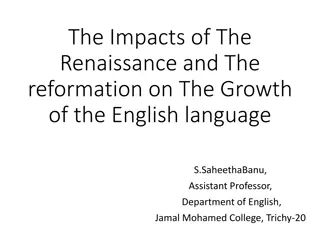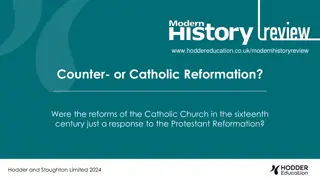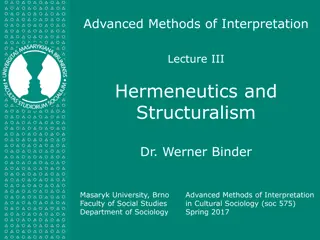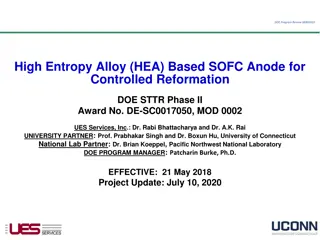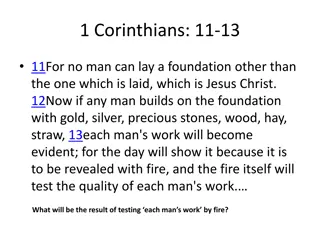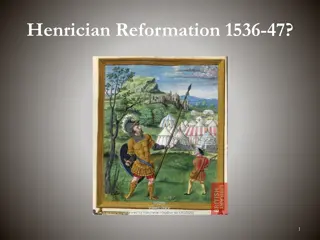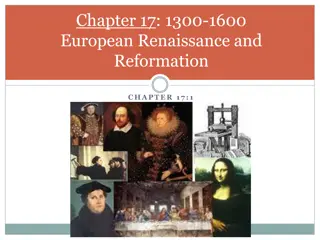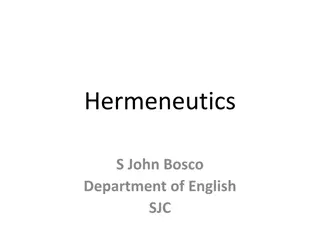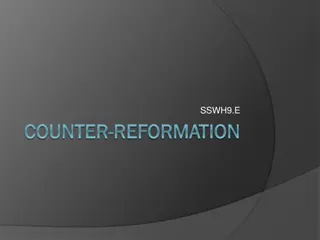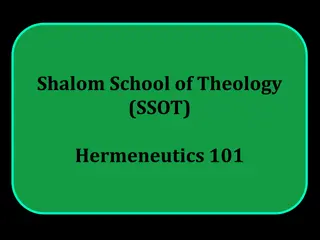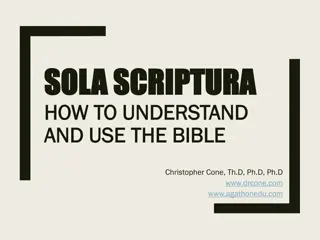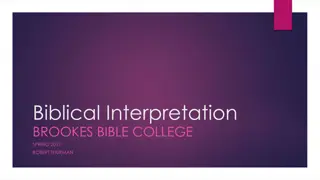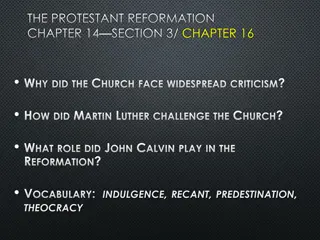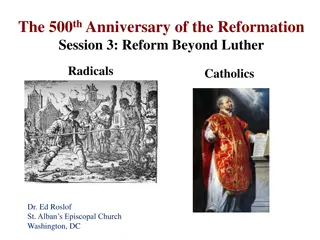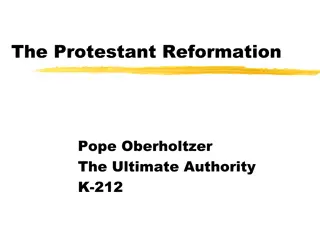Hermeneutics and the Reformation: Principles and Methods
The Protestant Reformation aimed to reform the Church by emphasizing biblical teachings over church tradition. It challenged the authority of the Roman Catholic Church and upheld principles such as Sola Scriptura, Sola Fide, Sola Gratia, Solo Christo, and Soli Deo Gloria. These principles emphasized the authority of Scripture, salvation by faith alone, salvation through grace alone, and salvation in Christ alone, opposing certain teachings of the Church.
Download Presentation

Please find below an Image/Link to download the presentation.
The content on the website is provided AS IS for your information and personal use only. It may not be sold, licensed, or shared on other websites without obtaining consent from the author. Download presentation by click this link. If you encounter any issues during the download, it is possible that the publisher has removed the file from their server.
E N D
Presentation Transcript
Hermeneutics and the Reformation: PRINCIPLES AND METHODS by Edwin Reynolds, PhD
The Protestant Reformation The Protestant Reformation was not about breaking away from the power of the Roman Catholic Church. It was about reforming the Church through a return to biblical teachings. The Roman Catholic Church had become corrupt through placing church tradition above the teachings of Scripture. It believed that its authority was superior to that of Scripture, that it could issue rulings and edicts that superceded Scripture. It held the keys to the kingdom of God, and its decisions were those of God Himself.
Reformation Principles The Reformation subscribed to 5 basic principles: 1. Sola Scriptura 2. Sola fide 3. Sola gratia 4. Solo Christo 5. Soli Dei gloria
1. Sola Scriptura The first principle was that Scripture and Scripture alone (sola Scriptura) was authoritative for teaching and practice for Christians. This stood in flagrant contrast to the teaching of the Church, namely, that it was the final authority for the believer, that Church tradition not only supplemented the Bible but was above the Bible. Scholasticism, especially Thomas Aquinas, had taught that reason and revelation were equals, that Scripture was not the final authority.
2. Sola Fide The second principle was that salvation was attainable through faith alone (sola fide), not earned through works of penance or receiving the sacraments of the Church. This was in direct conflict with the teaching of the Church, namely, that believers must receive the seven sacraments of the Church in order to be saved, and must also practice deeds of charity, pay penance, make pilgrimages, and venerate saints and relics.
3. Sola Gratia The third principle was that salvation was by grace alone (sola gratia), an unmerited gift from God, not something that the Church could dole out based on the believer s performance. This principle denied the Church s teaching that it held the keys to the kingdom and could bind or release the individual with respect to salvation based on their doing what the Church required. Not the grace of God alone could avail, but the merits of the saints needed to be added, as distributed by the Church to the penitent.
4. Solo Christo The fourth principle was that salvation is found in Christ alone (solo Christo). The once-for-all sacrifice of Christ was sufficient to atone for our sins and provide for our salvation. This principle stood in direct defiance of the Church s teaching that Christ s sacrifice on the cross was insufficient to atone for sins, but the penitent must come to the church and confess to a priest, pay due penance, and receive the daily sacrifice of the mass distributed by the priest.
5. Soli Dei Gloria The fifth principle was that, since salvation is from the gracious gift of God alone, through Christ s sacrifice of atonement, with no human merit or work required, to God alone belongs the glory (soli Dei Gloria). This principle entirely eviscerated the claims of the Church to authority, glory, and power because of its claim to be able to dispense salvation on its own terms. The believer could be saved by a direct, unmediated relationship with God.
Understanding Sola Scriptura Sola Scriptura was the most fundamental of the five principles of the Reformation. It was on this principle that the other four could be established. Not only did it prioritize Scripture over tradition and human reason, but it also included a clear understanding of what constituted Scripture. The Reformers excluded the deuterocanonical works (OT Apocrypha) from Scripture. The Reformers insisted that Scripture designated works in their original languages, not in the Vulgate.
Challenging the Latin Vulgate For over a thousand years, Jerome s Latin Vulgate had served as Scripture for the Roman Church, while the Greek and Hebrew texts were not preserved. When the Ottoman Turks laid siege to Constantin- ople in 1453, many biblical manuscripts held there by the Eastern Church were brought to the West to save them from destruction. The Reformers placed great value on these texts as having priority over the Vulgate in determining the teaching of Scripture. This was transformational.
Translating Scripture into the Vernacular Languages The availability of Greek and Hebrew texts under the European Renaissance spurred philological study and resulted in the Reformer s interest in translating these texts into vernacular languages. Erasmus and Luther translated the Scriptures from the original languages into German, making it possible for people to read the Scriptures for themselves instead of being dependent on the priests and monks to interpret the Latin for them.
Widespread Access to Scripture Gutenberg s development of the printing press enabled widespread access to the vernacular Scriptures that undermined the unscriptural teachings of the Roman Catholic Church. Now people could check out the teachings of the Church from Scripture and see where the teachings of the priests and monks deviated from the teachings of Scripture. This was a key to the success of the Reformation. People had unmediated access to Scripture.
Theology vs. Hermeneutics The Magisterial (mainstream) Reformers did not set out to reform hermeneutics. Rather, they utilized the existing hermeneutics of the Roman Church until their reading of Scripture changed their theology. At that point they had to adopt a new hermeneutic that would correctly interpret Scripture to agree with the early Christian church. The teaching of the early Christian church, rather than the medieval teaching of the Roman Church, became the test of correct interpretation.
Reformation Hermeneutics Early Reformation hermeneutics were mixed. While some Reformers continued using the allegorical method, others used the tropological (moral) method, and others used a literal method. Over time, the literal reading of Scripture came to prevail because it best produced the teaching of the early church. It was referred to as the grammatical reading, not because it emphasized grammar but because in Greek gramma means letters. It meant a literal reading, emphasizing the text just as it reads.
Martin Luthers Hermeneutics Luther was trained as a scholastic theologian and preferred the tropological interpretation in his earlier years, although he also utilized both the literal and the allegorical interpretations. His biblical expositions led him theologically to develop a unique Christological interpretation in which he taught that everything in Scripture must point to Christ in order to have authority for the Christian. He questioned the authority of biblical books, like James, that did not point to Christ.
Ulrich Zwinglis Hermeneutics Zwingli was basically a humanist like Erasmus (not a secular humanist but a Renaissance humanist). Humanists made Scripture available in the original languages and practiced biblical exegesis as the basis for a religious experience. For Zwingli, Scripture was the means for achieving a mediated encounter with the risen Christ. Using a typological method grounded in a literal, historical reading, he developed a dialectical approach to the word and sense of Scripture.
Martin Bucers Hermeneutics Bucer totally rejected the allegorical method, since it allows human ideas to be imposed on Scripture so that any interpretation can be read into it. He saw the historical sense as fundamental, though its relevance must be discerned under the guidance of the Holy Spirit. Bucer also emphasized the tropological, in that Scripture is oriented toward the practical questions of human existence. The believer is empowered by the Spirit to fulfill the demands of the gospel.
John Calvins Hermeneutics Calvin made a decisive break with the moralist (tropological) interpretation of Scripture. His exegetical method was grounded in a literal, historical (historical-grammatical) interpretation. He determined to make biblical commentaries widely available, to give access to Holy Scripture to all the children of God, in order that they might really understand it. By this means he propagated the Reformed ideas of the Genevan Reformation. His exegesis of Scripture is still highly regarded.
Seeking for Plain Meaning The Reformers believed that the Scriptures were comprehensible to all, not only to the priests and scholars of the Church. The plain meaning of the text could be made available to everyone by translations that were faithful to the original. It was necessary to study the grammar and the vocabulary of the original languages to do this, but no one doubted that this was an objective science that did not depend on one s theological orientation.
The Importance of a Faith Context The Reformers believed that the Bible needs to be read in a theological context, whether the context was imposed from without or discovered from within. It reflects a coherent system of thought, namely, the faith of the church. A critical attitude toward the text was regarded as a sign of unbelief and was not acceptable. Only later did a critical attitude toward Scripture develop (during the 18th-century Enlightenment).
Scriptura Sui Ipsius Interpres The key issue that separated Protestants from Catholics was whether Scripture interprets itself (sui ipsius interpres) or requires the teaching authority of the Church to interpret it correctly. The Roman Church had long taught that only those invested with the teaching authority of the Church could correctly interpret Scripture, but the Reformers taught that Scripture was self- interpreting and could be understood by any careful, believing student of Scripture.
The Analogy of Faith There was general agreement as time progressed that most of the Bible could be understood clearly and should be interpreted in the literal sense. Those parts of the Bible that were not so clear were to be interpreted according to what was called the analogy of faith. This meant that the less clear passages were to be understood in agreement with the clearer passages, and nothing was to be inferred from the unclear texts that could not be proved from a clearer text.
Explicit vs. Implicit Teaching More radical Protestants taught that only what could be proved by Scripture could be required, while more liberal ones taught that all practices should be allowed that are not expressly forbidden. Most Reformers agreed that a teaching did not need to be explicitly spelled out but could be taught if a doctrine was consistently implicit in the biblical text (such as the doctrine of the Trinity). The language, but not the substance, of systematic theology might be derived from outside of Scripture.
The Biblical Canon Since Jerome translated the Bible into Latin (A.D. 400), including the apocryphal additions to the Septuagint, the Roman Church had used these additions as Scripture to teach doctrines like the doctrine of purgatory. The Reformers agreed that the Hebrew canon was the only one that should be used for the OT . Although the Council of Trent subsequently voted to retain the apocryphal intertestamental works, they came to be classified as deuterocanonical.
Views of Revelation and Inspiration For the first generation of Reformers, Scripture was the voice of Christ speaking to His church through the text. Just as Christ in His humanity could have physical imperfections without compromising His divinity and teaching authority, the Scripture could have imperfections and still be infallible in its teaching. Thus, text criticism was not a significant factor for the early Reformers. God preserved His message pure, despite variants in the biblical texts.
The Role of Covenant Theology Calvin was a systematician who sought to find a balance between text, meaning, and application. His work led to the development of a covenant theology that tied together the various aspects of the history of God s people through the ages. The Bible is the story of God s relationship to humankind. It is the story of God s grace to every generation through His covenant with them. The details may change, but God s love and grace are unchanging. Sharing the gospel is sharing the story of His grace, which unites humanity together.
The Historical-Grammatical Method Also called the grammatico-historical method, this method is based on exegetical principles and textual analysis, including textual criticism, but, unlike historical criticism, remains committed to the divine inspiration and infallibility of the text. The exegetical principles, which were worked out already by the time of Erasmus, were adopted by the Reformers and used to counter the allegorical, philosophical, and other interpretations of the Roman Church, which led to unbiblical teachings.
Historical-Grammatical Principles1 Basic to the historical-grammatical method was the principle that the meaning of a word must be determined from its literary context, beginning with the local context and moving outward to its canonical context (to confirm that its rendition is in harmony with the theology of Scripture). It was assumed that the biblical text made sense both to its writer and to its original readers. Scripture is understood to be a self-interpreting unity, authoritative in religious matters and consistent in its teaching.
Historical-Grammatical Principles2 Study of the historical-cultural conditions of the times in which the text was written is important for understanding the situation being addressed. Basic to interpretation is a correct understanding of the relationship between law and gospel. In evaluating variants it was assumed that later scribes tended to simplify difficulties, leading to the text-critical principle of lectio difficilior. The interpreter must be illumined by the Holy Spirit, yielding a sola fide and sola gratia experience.
Influence on Seventh-day Adventism The Seventh-day Adventist Church sees itself as the extension of the Reformation. When the Reformers died and their followers settled into creedalism, God raised up a movement to carry out what the Reformation failed to complete. While the Reformation was imperfect and incomplete, its biblical principles were ordained of God and need to be brought to completion. The 1986 Methods of Bible Study document is grounded in the historical-grammatical method.
Conclusions God raised up the Protestant Reformation to return people s minds to the Scriptures and to Christ, to reform Christianity from its corruption. Critical in this process was a biblical hermeneutic that would provide for a valid reading of Scripture and a valid text from which to work. This historical-grammatical method was effective in restoring truth to Christianity, and it is still needed to separate truth from error in this postmodern age. Any deviation from this method poses a danger.


